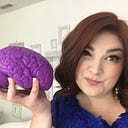Unlocking the Secrets of the Brain
Have you ever had that moment? Where in an instant you know your whole life has changed; that you can never go back to the way things were before?
I’ve had several of these moments in my life. Truth be told, I’m easily distracted and pretty sure the character of Dug from Up was loosely based on my life…
I get excited and distracted easily, quickly moving on to the next shiny object before I finish with the original squirrel.
But every so often a moment comes along that I can’t ignore.
Like when I found behavioral economics.
The first “moment” came almost 10 years before I heard those two words uttered together — in the last class of my undergrad program in marketing, one section of one book in one class was about the psychology of buying behavior…and I was hooked.
After spending the better part of a decade searching for a master’s program in what I was calling behavioral psychology, it was starting to look like this dream would never be realized.
And then the next moment came.
While attending an event in Denver, one of the presentations for our innovation group was from the Center for Advanced Hindsight at Duke University. They were talking about their research and findings and it hit me like a ton of bricks: this is what I have been searching for.
Are you sure that’s what it’s called?
As a marketer, I will admit I didn’t find the name “behavioral economics” to be particularly sexy (it’s definitely more steak than sizzle), but it’s grown on me over the years.
I like to say, if economics and psychology had a baby, you would have behavioral economics.
The field came about because traditional economic models assume logical people making rational choices. Unfortunately, that’s not the world we live in. So economists and psychologists started working together (or entering into each others’ fields) looking for the common threads in the way humans make choices to see if it was predictable.
And you know what? It really, really is.
The Subconscious Makes 99% of Decisions
Even though we all have brains, it turns out we don’t really understand how they work.

Our brains are busy — if you were to think of your brains as a computer, the subconscious can process around 11 million bits of information every second. The conscious brain can do about 40.
Yikes.
Talk about a discrepancy.
The subconscious brain is making most of your decisions and is basically like a small child: driven by strong visuals, treats and immediate gratification.
The Subconscious Is The Gatekeeper
Think of your subconscious brain like the gatekeeper — or the receptionist that only lets special people in to see the busy executive. He or she has rules they use to determine who gets to see “the boss.” And our brains work in the same basic way.
Your subconscious is constantly scanning the environment around you. Most items it has a rule for and acts accordingly. But every so often, something needs the focus and attention of the conscious brain.
Think about when you first learned to drive a car. It was a very cumbersome, slow and difficult process (especially if you learned driving a stick shift). Then, over time, it got easier. Now you can drive “without really thinking about it” right?
That is because your subconscious brain has taken over and it has moved into automatic processing. You have done it enough that the brain has rules to follow…until it’s pouring rain and you are between a semi truck and a guardrail…then your conscious brain gets alerted so you can focus on the matter at hand.
The Problem (and Opportunity) for Business
So, 99% of decisions (including whether to buy your product or service) happen on a subconscious level, which is often irrational.
What part of your brain do you think you use when you sit down to write your business plan? Or create a new product? Or create an advertising campaign?
That’s right — the conscious, logical brain.
If you find yourself saying “should” a lot (i.e. “people should be able to calculate interest rates in their head” “everyone should see the value in this”) there’s a good chance your conscious brain is creating things that will not communicate properly with the subconscious.
Did I mention they don’t speak the same language?
Our brains are weird, and consumers don’t often do what they “should.” We go bananas over beanie babies, binge-watch Netflix and claim we don’t have enough time to exercise, and vow to start eating right on Monday (a magical time that never actually manifests).
Behavioral economics has found the underlying rules for all these behaviors so we can understand ourselves (and our customers) a little better.
Because of this, behavioral economics is the future of marketing. The future of product design. The future of pricing models and brands. This field is uncovering the ways everyone makes decisions all the time, and I love helping people understand how it works and how to apply the concepts in their businesses.
If you are new to behavioral economics, I hope this article triggered a “moment” like I first had on that fateful day as an undergrad. Where you realize there is more going on beneath the surface…and that you can’t wait to learn more (and more and more).
Are you ready for the future of business?
— — — — — — — — —
Found this article useful? Please 👏 this article to share it! Follow me (Melina Palmer) on Medium and let’s connect:
